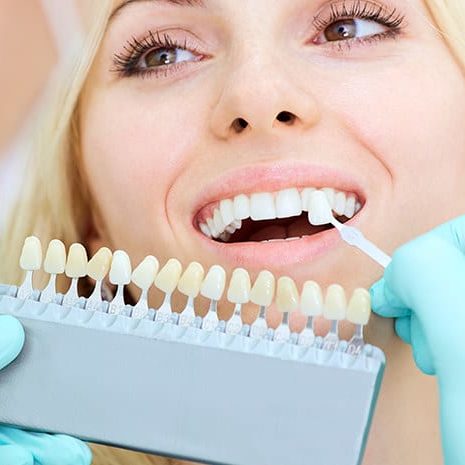Dental crowns are one of the most commonly performed procedures in the dental office. They are tooth-shaped caps that are placed on decayed or damaged teeth to retain their structural and functional integrity. Dental crowns may be made from metals like gold or stainless steel, or tooth-colored ceramics like porcelain. Once cemented into place, the dental crown completely encases the tooth and help restores the appearance, strength and function of the tooth.
Table of Contents
When is a Dental Crown Needed?
- In teeth with large fillings or after a root canal procedure, the structural strength of a tooth is greatly compromised. Placing a dental crown on such a tooth helps protect it from potential fracture.
- Dental crowns are used as part of the framework in a dental bridge. The artificial tooth in a dental bridge is suspended between dental crowns on either side of it. These dental crowns are cemented onto the abutment teeth adjacent to the missing tooth.
- Teeth that are discoloured, stained or misshapen, and cannot be fixed with teeth whitening or dental veneers, can be restored with porcelain dental crowns.
- A cracked or broken tooth that is still vital can be held together in place with the help of a dental crown.
- Dental crowns make up an important part of the dental implant framework and take the place of the missing tooth in the mouth during the dental implant procedure.
- Stainless steel dental crowns are also given in primary teeth of children that have been affected by decay or damage. This is done to prevent the premature loss of primary teeth, which can affect the timely eruption of permanent teeth and cause misalignment problems in the future.
How is the Dental Crown Procedure Done?
The procedure for getting a dental crown is a simple one that usually does not extend beyond 2-3 appointments. Once the tooth has been treated for any decay or damage it might have, the outer enamel layer of the tooth is trimmed down. This is done to make room for the dental crown that will be placed on it. Most teeth getting a dental crown are first treated with root canal procedure.
The amount of enamel removed from the tooth depends on the kind of dental crown being used. Metal crowns made from stainless steel are sturdier and can be made very thin. For this reason, teeth receiving metal crowns do not need to be trimmed down as much as those that receive porcelain or porcelain-fused-to-metal crowns. Porcelain crowns are made thicker than metal crowns to make them stronger; due to this, teeth prepared for porcelain crowns are trimmed down much more to accommodate the dental crown.
After the tooth preparation, the dentist takes an impression of the tooth and sends it to the dental laboratory for fabrication. A temporary dental crown is placed onto the tooth for about a couple of weeks till the permanent dental crown arrives from the laboratory. The temporary crown protects the tooth from sensitivity and potential fracture before it can be restored with a permanent crown.
On a subsequent visit, the permanent crown is cemented onto the tooth after it has been checked for the right fit. The dentist will also check the bite of the patient to make sure that the crown does not sit higher than the remaining teeth. Any adjustments that may be required with the dental crown are made before the crown is cemented into place.
Caring for Dental Crowns
Just like your natural teeth, your dental crowns also need proper oral hygiene measures for their maintenance and long life. Food and plaque accumulating at the tooth-crown interface is a common problem that can lead to decay of the tooth underneath the dental crown. Brushing your teeth at least twice a day and regularly flossing, especially around your dental crowns, is an important part of maintaining the longevity of your dental crown.
Patients are also advised to avoid chewing on hard foods like nuts or ice, which can lead to fracture of the dental crown. Sticky foods like chewing gum hold a risk of dislodging the dental crown and should be avoided as well.
People who suffer from habitual grinding or clenching problems may damage their dental crowns over time. Such people can benefit greatly from wearing a mouth-guard while sleeping to protect the structural integrity of their dental crown.
It is also advised for people with dental crowns to go for regular check-ups to the dentist to keep any potential dental problems away.
Complications with Dental Crowns
With the right care, complications usually do not arise with dental crowns. However, some people may experience some problems associated with them like:
- Tooth sensitivity and discomfort immediately after getting a dental crown. This usually goes away after a few days as the patient gradually adapts to eating and talking with the dental crown.
- A dental crown that becomes loose after a few days. This occurs due to an improperly fitted crown or due to the cement leaching out from between the tooth-crown interface.
- A crack or fracture of the dental crown that may occur while eating or biting onto something. This is more common with ceramic crowns, which is why patients are advised to avoid eating or biting down on hard foods with their dental crowns. Small chips occurring in dental crowns can occasionally be fixed by the dentist. An example of such a fracture is when a small portion of porcelain chips off from a PFM crown. As long as the metal layer underneath is intact, the porcelain layer can be repaired.
- Allergic reactions, although rare, may occur due to the metal component of a dental crown.
- Gum disease is a potential complication that arises in individuals with poor oral hygiene. Dental crowns increase the probability of plaque and food accumulation around the edges of the crown, which needs to be cleaned regularly to avoid development of gum disease.
Visit Anoka Dental today to know more about the dental crown procedure and which type of dental crown is best suited for you.




